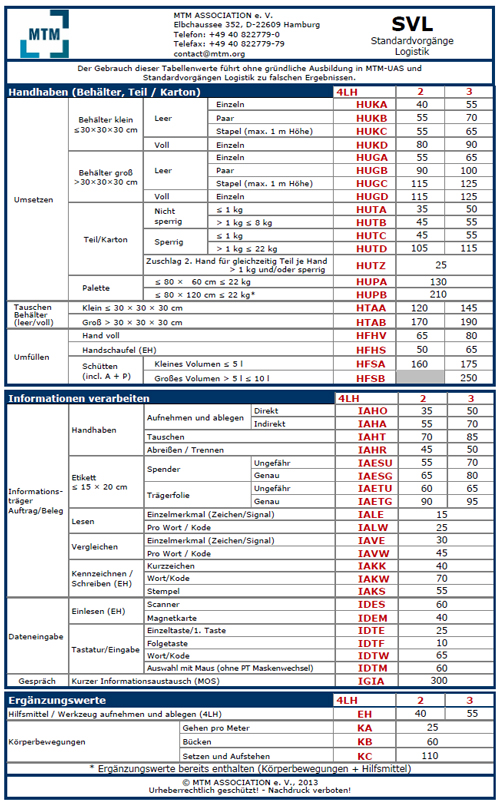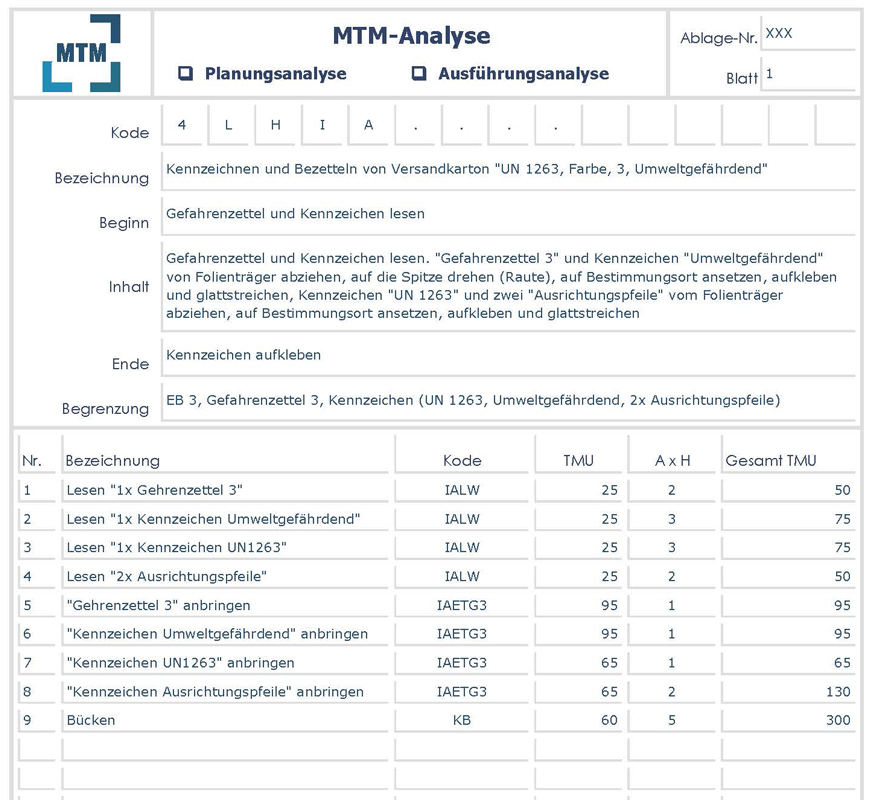
Additional effort is calculable.
TIME MANAGEMENT – Dangerous goods processes can be measured in time. And they have to be. Cost pressure in logistics requires an efficient and reliable basis for calculation.
Everything can be calculated if you want it to be! But does this also apply to dangerous goods processes? The deployment times of employees play a particularly important role for logistics service providers. But is it possible to control the timing of dangerous goods processes and calculate the associated costs before a logistics service provider accepts a dangerous goods customer?
Introduction: Cost pressure in logistics
Against the backdrop of increasing cost pressure in logistics, more and more companies are using time measurement methods to eliminate waste in their operations. As dangerous goods processes are an important and time-consuming part of logistics in some companies, time studies are required to assess the workload and additional costs of dangerous goods. However, logistics service providers often underestimate the time and cost involved. In order to remedy this and provide the contractor with a comprehensible basis for calculation, various time calculation methods are available; the REFA and MTM methods will be discussed here.
Methods of time determination: REFA and MTM
One of the best-known methods of time determination is time recording according to REFA (determining target times by measuring and evaluating actual times with the help of a time recording device). Time recording according to REFA is therefore a method for evaluating the current situation in terms of time. It requires an existing work system. Another well-known method is time measurement according to MTM (Methods-Time Measurement). This is a method for analyzing work processes and determining planned and target times. MTM focuses on the TARGET situation, but can also determine the ACTUAL situation. It therefore offers a well-founded analysis as early as the planning phase, i.e. before the work system even exists. When planning new dangerous goods processes in particular, the logistics service provider can therefore describe all dangerous goods-related activities and evaluate them in terms of time before accepting a potential dangerous goods customer and implementing the processes.
The MTM process building block systems
At the beginning of the 1940s, American ergonomists arranged the inventory of movement elements that make up manual activities into so-called basic movements. A scientifically proven and standardized time value was determined for each of these basic movements and compiled in the MTM 1 standard time value card (MTM basic system), which is still valid today. Later, a large number of other MTM process module systems were developed for use in various branches of industry and sectors. MTM – specifically the MTM-Logistics (MTM-LOG) process building block system – can also contribute to the design of productive and healthy work when considering logistics processes in which people are operationally involved. The MTM-LOG process building block system is based on the MTM-UAS (Universal Analysis System) basic processes, which have been combined into typical standard processes in logistics, such as picking, transporting, packing or checking. To analyze these typical processes, the data card for standard processes in logistics (SVL) should be used (see Figure 1, right). The SVL data card only covers a part of logistics activities, e.g. activities with industrial trucks and cranes, handling cartons, etc. For activities that fall under dangerous goods legislation, separate modules may need to be created with MTM-LOG and/or MTM-UAS.
Training for the correct use of MTM
Certified training in MTM-1 Base (one week) and MTM-LOG (one week) is required for the correct use of MTM-LOG. Without thorough training, the use of the MTM process modules will lead to incorrect analysis results. This is specifically pointed out on every MTM ASSOCIATION e. V. data card. Similar to the dangerous goods officer training, a minimum number of points is required for MTM training. However, 50 percent is not enough to pass. According to the training and examination regulations of the MTM ASSOCIATION e. V., 75% is required. Without knowledge of the MTM process language and the MTM-LOG building block system, however, it makes no sense to use them in practice. The following practical example should contribute to a better understanding and illustrate the concrete benefits of the MTM application.


Practical example: Labeling dangerous goods
A logistics service provider that does not usually pack dangerous goods would like to know how much extra work is involved in packing dangerous goods. The employee (packer) of the logistics service provider is to label a hazardous goods box with the “Hazard label sample no. 3” and mark it with the labels for “environmentally hazardous”, “UN 1263” and two “alignment arrows”. To do this, he reads on the computer which hazard labels and markings are to be affixed and picks up the hazard label and the markings on the roll one after the other. The employee sticks the labels on one side of the hazardous goods carton – with the exception of the alignment arrows, which must be attached on two opposite sides. Figure 3 on page 29 shows how this should look in practice.
For the regularly instructed packer according to chapter 1.3 ADR, this is a completely normal and understandable work process. However, this information is not sufficient for the MTM time analysis. The MTM analyst who is to evaluate the activity in terms of time requires the following additional information, known as influencing variables:
- Number of words/codes required to record (read) which hazard labels and markings are required
- Distance range 2 (≤ 50 cm) or 3 (> 50 cm and ≤ 80 cm)
- Size of the hazard label and license plates
- How are hazard labels/markers available: on carrier foil or dispenser?
- How should the hazard labels be affixed: exactly or approximately?
- What other postures play a role? Does the packer have to bend down, for example?
Once the data has been determined, the MTM analyst can carry out the MTM analysis. MTM provides special forms for this purpose (see Figure 2 above). First, it must be determined whether it is a planning analysis (no existing process) or an execution analysis (existing process). A code must also be defined for the activity, which can then be used as a new process module for more complex analyses. The delimitation of the activity is reflected by the content. The exact start and end of the activity are particularly important here in order to differentiate it from other activities. The analysis is carried out in TMU = Time Measurement Unit. One second corresponds to 27.8 TMU or vice versa: one TMU corresponds to 0.036 seconds.
Figure 2 on the left shows an MTM analysis for the marking and labeling of a package in accordance with dangerous goods regulations. Only the MTM-LOG data card (see Figure 1 on page 27) was used for the analysis so as not to make the practical example too complex. As already mentioned, company-specific process modules using MTM-LOG and/or MTM-UAS may need to be developed for similar activities.
Explanatory note to no. 1 to 4 (code “IALW”)
The packer receives the information as to which danger label and which markings are to be applied via a display on the computer. The MTMLOG process module system has a data card for reading words or codes, which shows the time value of the activity (see Figure 1 on page 27). For a single word or a maximum six-digit code, the time value must be included once in the analysis. If the text “1 × Environmentally hazardous indicator” is to be read, the time value 25/code IALW must therefore be multiplied by three.
Explanatory note to serial nos. 5 to 8 (code “IAETG3” and “IAETU3”)
The “hazard label 3” has a minimum size of 100 × 100 mm and must have the shape of an upside-down square (diamond) on the shipping carton (section 5.2.2.2.1.1.2 ADR). The minimum size of 100 × 100 mm also applies to the “environmentally hazardous” mark, which must also have the shape of an upside-down square (5.2.1.8.3 ADR). For the “UN 1263” mark, there are no specifications regarding the size of the mark, with the exception of a mark height of at least 12 mm for a package (here: carton) greater than 30 kg or L (subsection 5.2.1.1 ADR). In this case, the “UN 1263” label has a size of 100 × 50 mm.
The mark for the “alignment arrows” must be affixed to two opposite sides of the package (here: carton) and must point correctly upwards. There is no minimum size requirement. However, the alignment arrows must be sufficiently visible according to the size of the package (here: carton) (section 5.2.1.10.1 ADR). In the present case, the two “alignment arrows” markings have a size of 105 × 74 mm. The distance range for picking up and affixing the hazard labels and markings is between > 50 cm and ≤ 80 cm in all cases. For the MTM analyst, this means distance range 3. The hazard label and the markings are removed from a carrier film (roll) and applied approximately. This means that precise positioning on the package is not required. When attaching the “Hazard label 3” and the “Environmentally hazardous” label, the attachment is precise because here the hazard label or the label must be turned in the hand so that it can be attached to the package standing on its tip. Figure 3 top right shows how the shipping carton is to be marked and labeled in accordance with ADR. MTM-LOG has a data card for attaching labels (hazard labels and identification marks) which shows the time value of the activity (see Fig. 1 on page 27). Depending on the size of the label, the placement accuracy and the distance range for picking up and placing, the corresponding code must be used.
Explanation for serial no. 9 (code “KB”)
To attach the hazard label and the four labels, the packer must bend down and stand up again a total of five times. This factor must also be included in the analysis.
Result of the MTM analysis and conclusion
Marking and labeling the shipping carton with “UN 1263”, “Hazard label 3”, “Environmentally hazardous” and “Alignment arrows” takes 935 TMU, which corresponds to 34 seconds. In this case, the packer has an additional effort of 34 seconds per shipping carton compared to a shipment that does not contain any dangerous goods. If one or more packers manage to mark and label 500 shipping cartons a day, for example, this represents almost five hours of additional work. If the result is then multiplied by 20 working days per month, the additional effort is already 100 hours.

As the logistics service provider usually works in its own buildings, dangerous goods are already transported from the manufacturer to the logistics service provider in advance. This means that the packages are already marked and labeled in accordance with dangerous goods regulations. However, picking work, repackaging, incorrect or damaged hazard labels/labels may result in new labeling and labeling activities.
It is also possible that the goods are transported onwards by ship.In addition to the ADR, the IMDG Code must then also be taken into account. The trained packer in accordance with Chapter 1.3 of the IMDG Code knows that the package in Figure 3 must then also be marked with the correct technical name (here: “color”). It is therefore essential that the package is checked for correct marking and labeling.
It should not be forgotten that there are, of course, other dangerous goods activities that may need to be recorded, such as the preparation of transport documents or checks before and/or after loading using checklists. In addition, there is the potential danger of dangerous goods for employees and compliance with storage regulations if the dangerous goods are also hazardous substances. Fines for storage or transportation are not uncommon.
Conclusion: Before accepting a dangerous goods customer, a logistics service provider should familiarize itself with the legal requirements for dangerous goods and calculate the additional costs in advance using an MTM analysis.In this way, unpleasant surprises can be avoided at the end of the year.
Source: Magazine for dangerous goods logistics “Gefährliche Ladung 08/2024”
Author: M. Sc. Christopher Ernst, hazardous materials and dangerous goods expert, Rhenus Warehousing Solutions Services GmbH & Co. KG
André Graichen andre.graichen@mtm.org will be happy to answer any further questions you may have on this topic or about the MTM organization’s consulting services in general.